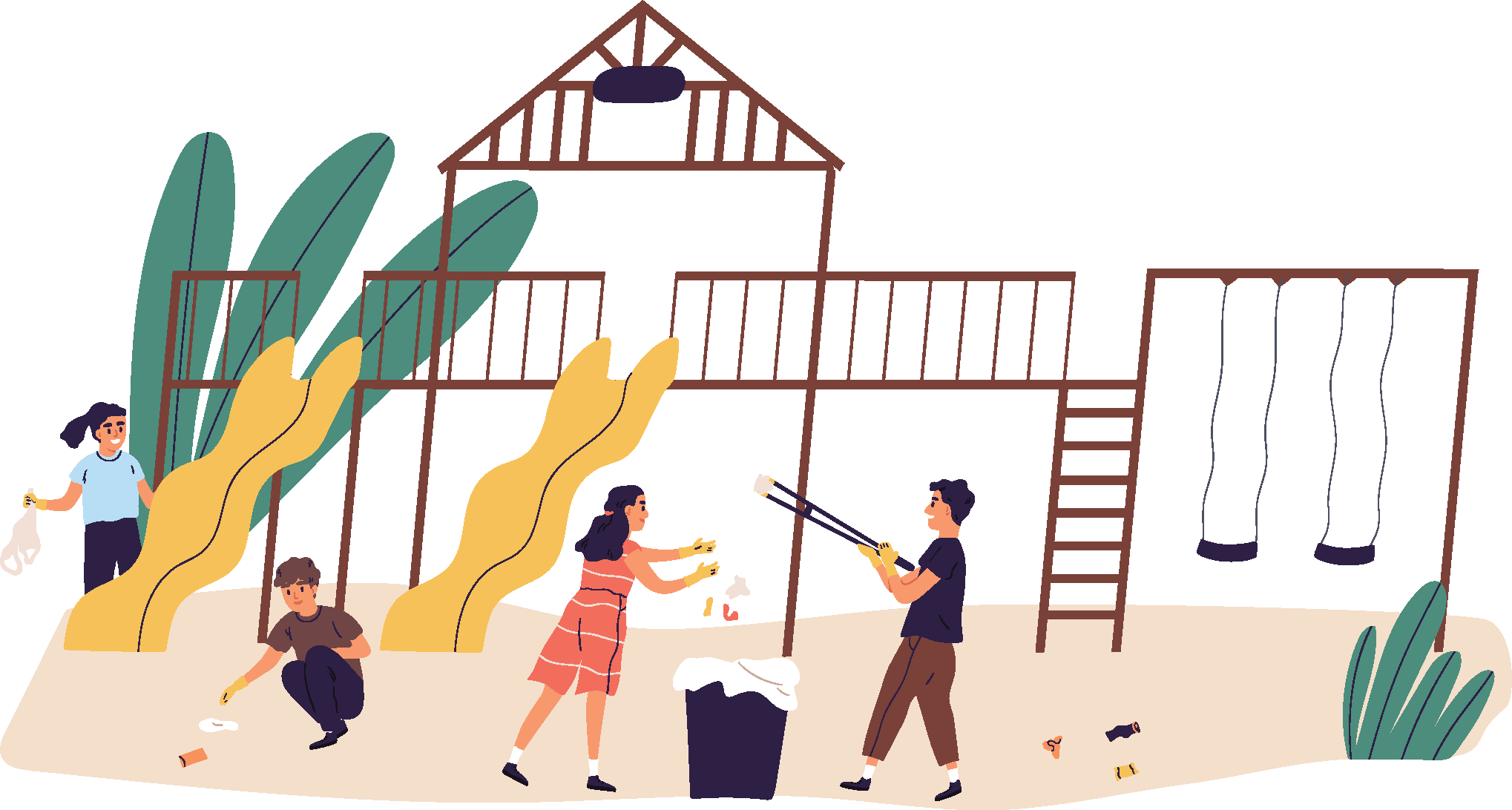To help our children become confident, caring, and capable adults, we need to teach them about their community. Through community engagement, our children gain invaluable life experiences while learning key life skills that will help them to have more successful futures.
Teaching kids about their communities and how they fit in gives all of us a sense of belonging to something bigger than ourselves.
Create a Community Mindset
Our community is basically a wealth of knowledge and support waiting to help us. Many of us rely on the convenience of the internet for immediate responses and support when we face challenges. Sometimes that’s helpful. Sometimes it’s disastrous.
Think of all the life experience you’ve had that allows you to properly filter what you’re reading, watching, or listening to online.
Our children don’t necessarily have that life experience yet. Without some media literacy training, they (and many adults) are likely to believe whatever source they come across.
That’s why we need our communities. We need real people we feel comfortable calling on to ask questions when the instructional YouTube video just doesn’t make sense or, more importantly, when we’re overloaded with conflicting online parenting advice and we just want to be with other parents and be able to talk to someone.
Our kids need to know that the internet is a very helpful tool in our lives but that using it comes with a learning curve. In the end, we as their parents and guides, along with the community of people we trust, are the MOST reliable sources of information and support.
To do this, though, we may need a community mindset makeover—we have to be open to putting ourselves out there, have a willingness to ask questions, be vulnerable, be willing to learn about other people, and be willing to get to know our community personally and not just through online reviews (e.g., talk to people in line at the grocery store, go to events in your area that look interesting, and talk with the repairman).
By modeling this behavior for our kids, we set the stage for our family’s community engagement. By regularly engaging with our community, we can benefit our family with knowledge, insights, information, and relationships. All of those translate into increased opportunities and resources to help our families achieve the life-long success we want.
Why I Teach My Kids to Be Active Members of Their Community and You Should Too
01 | I don’t want to be responsible for raising yet another overly confident kid who can look up the answer to any question on the internet but won’t ask for help in a store because that’s weird or embarrassing.
The internet is only as smart as the question you ask it. I appreciate a quick tutorial on occasion, but if there’s a 75-year-old man at the hardware store still fixing screens, I’m going to ask him how to fix my window and what else I need to know to maintain stuff in my house. I trust his experience more than whatever Up Next video the great algorithm in the cloud has decided would best fit my interests. I want my kids to do the same.
02 | I don’t want my child to have aced every test and succeeded academically her whole life but feel lost and alone as a 24-year-old young professional because she’s too shy to join a team or show up to a community event where she doesn’t already know people and how everything works.
Being comfortable with vulnerability and learning that most people are really eager to help others is not something she’s going to learn on TikTok. I need to show her what’s possible in her own real-life community.
03 | I do want my kids to shop at local small businesses as much as possible, not from a place of negativity because they saw someone else’s internet campaign to boycott big business but from a place of joy knowing those small businesses are run by their friends and neighbors whom they care about and want to see thrive.
Leading your life through positive intentions is infinitely more satisfying.
04 | I want my children to be confident that wherever life takes them geographically, they’ll know that their voice and their vote are powerful things and they absolutely do matter in influencing how things work.
Rules are being made all the time, and we have the chance to shape our existence if we’re aware how those decisions are being made and by whom. They need to know how cities and communities work to feel connected and in touch.
Basically, it helps them (and us) develop a stronger sense of community pride, ownership, social awareness, and concern for other people and the environment.
It also just makes us feel good. You’re capable of raising magnificent future citizens because you’re already doing it. You’re here reading this article thinking about big ideas and how you can make a difference.
Now for the practical bit.
How to Teach Children about Community Engagement (Even the Very Little Ones)
Define Your Community
Our communities are made up of the people and places that make our lives possible and are working for the common good. They are the resources and relationships that we constantly depend on.
01 | Identify people you regularly see or have contact with.
They are the easiest to identify and relate to for young children. It may be necessary to distinguish between peer groups and community members overall.
Example:
- First responders (police/fire/ambulance)
- Healthcare providers (doctors/dentists/nurses/midwives/doulas/veterinarians)
- Garbagemen and street sweepers
- Teachers/coaches/trainers
- Families from school
- Farmer’s market vendors
- Neighbors
- Employees at businesses and restaurants you visit frequently
- Homeless people
This can be done either through a focused lesson or mentioned casually as opportunities arise.
02 | Identify public places you visit, emphasizing their value to the community.
Example:
- Parks
- Beaches
- Gardens
- Schools
- Libraries
- Skate parks
03 | Identify organizations that serve the community and what they do.
Emphasize groups that you donate time or money to and explain why. This is a great way to pass on your family values.
Example:
- YMCA
- Social activist groups
- Environmental groups
- Service organizations (Rotary, Kiwanis, Lions Club, etc.)
- The Red Cross
- Salvation Army
- Schools groups (PTA, etc.)
- Animal shelters
- Goodwill stores
- Habitat for Humanity
- Youth scouting organizations
- Youth and adult sports teams
- City councils
- University foundations
- Family crisis centers

Get Active in Your Community
Think about the people and places you want to interact with based on your values, then start creating your values-based support team. The people and places that make up your support team can vary greatly from someone else’s because they are based on your values.
Here are a few examples of who can be a part of your support team and how they can vary based on your values:
- Did you choose your mechanic because you trust them to tell you the truth about what work needs to be done, or did you choose them because they are close and it’s more convenient?
- Why do you go to the grocery store that you do? Is it because they have a wider range of organic foods, are the most convenient or cheapest, or have the lowest waste packaging?
- Why do your children go to the school that they do? Is it your neighborhood school or an alternative style of learning like Montessori or Waldorf?
Based on what is important to each of us (our values), we can choose very different providers.
With your values and discussions of the people and places that make up your community, pick a family service project at your next family meeting. Keep in mind community services you use on a regular basis.
Consider joining a service or scouting organization or choosing a charity to donate to as a family.
Volunteer to be a docent somewhere or plant a garden. This article has tons of great suggestions to get the family involved in serving the community.
Go visit the civil service locations and talk about what gets done there (police station, fire station, city council meeting, water treatment plant, animal shelters). Discuss why you’re grateful for these and other groups that serve the common good.
And keep the conversation going.
Like everything else related to parenting, this isn’t a one-and-done type of activity. Our communities are evolving all the time. We have the power to shape them with our votes and how we spend our time and money, all of which are major indicators of our values in life.
Communities Are People and Places
Our kids are fully capable of participating in the community if we help them understand how things work and how things can change.
Of all the terrible things that have happened, hopefully, the isolation of the COVID-19 pandemic has reminded us all how much we need each other.
If you’ve seen small businesses shut down in your community because of COVID-related issues, you know how bleak the landscape can be when we don’t support the people closest to us.
Getting out into your community and experiencing it by having real-world experiences is so much more impactful than virtual ones. It stirs our humanity in a way that anonymous online engagement can never replicate.
Community Engagement Plan of Action
So remember, start with a mindset about the importance of community. Talk with your family about why we need people running local businesses, why we need people to do dangerous jobs like providing emergency services. Think about how simple gestures can brighten your day and those around you.
Then identify the relevant people and places that line up with your values. Once you’ve done that, get out and experience the real world in your community and get involved with community-based activities and service.
When you do this, you’ll be ensuring your children learn valuable life skills, gain invaluable life experiences, know how to interact with real people, and feel comfortable asking for help. By teaching your children about community engagement and getting your family involved in your own community, you can be confident that your children will have the knowledge they need to lead a successful life. So don’t wait—start engaging now!
Resource and Activity Guide
What is a Community?
Activities and Ideas for Families to Explore Together
-
- Perfect for families with children of all ages
- Help kids explore the people, places, and organizations that make-up their community
- Help the family identify ways to donate to, volunteer, with and appreciate their surroundings
What To Do Next
1. Read more in the blog:
The Family Wisdom Blog shares valuable ideas across diverse topics.
2. Explore the Printables Library:
Our printables library is filled with must-have activity ideas, checklists, guides, and workbooks.
3. Subscribe to Our Newsletter:
Sign up for our newsletter for parenting tips to help you create the family team you've always wanted.
Somer Loomis
Somer is the Chief Content Officer at Raising Families living in Southern California with her seven-year-old son and two-year-old daughter. She spent 10 years in the architecture field as a designer and medical planner and now applies her love of integrative thinking and big-picture planning to her family and career.
In her free time she loves to try new recipes she knows her children will never eat and do art projects she saved on Pinterest at least five years ago. Read full bio >>




